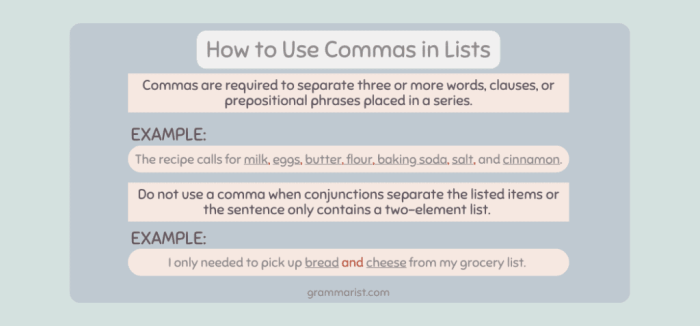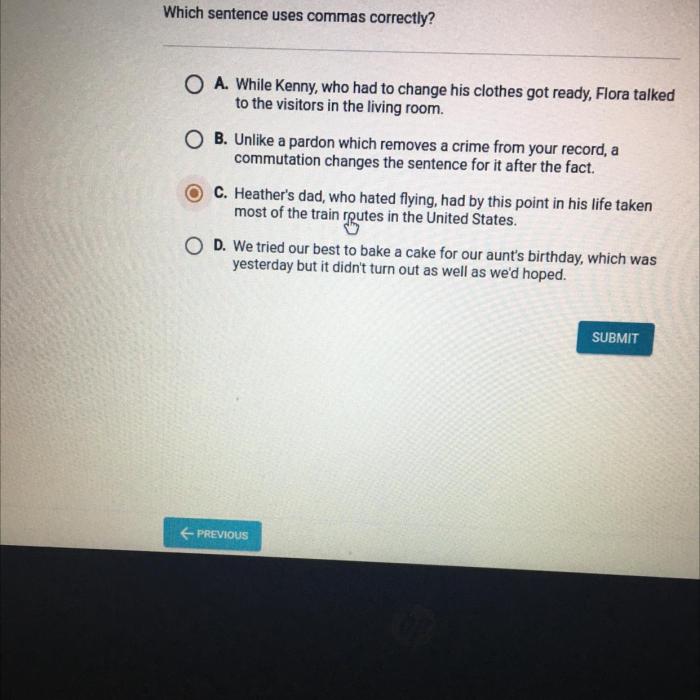Which sentence correctly uses commas – In the realm of written communication, the judicious use of commas plays a pivotal role in conveying clarity and precision. This comprehensive guide delves into the intricate rules and guidelines governing comma usage, empowering writers with the knowledge to navigate the nuances of punctuation and elevate their writing to new heights.
From separating independent clauses to setting off introductory elements, this guide provides an in-depth exploration of the various contexts in which commas are employed. By mastering these principles, writers can effectively avoid common pitfalls such as comma splices and run-on sentences, ensuring that their written messages are both grammatically sound and effortlessly readable.
Punctuating Independent Clauses
When two independent clauses are joined by a coordinating conjunction (and, but, or, nor, for, so, yet), a comma is typically used to separate them. This is known as the comma rule for independent clauses.
Rules for Comma Usage
- Use a comma before the coordinating conjunction.For example: “I went to the store, but I didn’t buy anything.”
- Do not use a comma if the independent clauses are short and closely related.For example: “I ate dinner and went to bed.”
- Use a semicolon instead of a comma if the independent clauses are long or complex.For example: “I went to the store; however, I didn’t buy anything.”
Separating Items in a Series
In English grammar, a series is a group of three or more words, phrases, or clauses that are listed one after another, usually separated by commas. Commas are used to separate items in a series to make the list easier to read and understand.
Exceptions and Special Cases, Which sentence correctly uses commas
There are a few exceptions and special cases to the rule of separating items in a series with commas:
- When the items in a series are connected by a conjunction (and, or, nor, but, for, so, yet), a comma is not used before the conjunction.
- When the items in a series are all short and simple, a comma may be omitted.
- When the items in a series are all numbers, a comma may be omitted.
Setting Off Introductory Elements

Introductory elements, such as dependent clauses or phrases, add context or background information to a sentence. They are often placed at the beginning of a sentence and are set off with commas to enhance clarity and readability.
Types of Introductory Elements that Require Commas
- Dependent clauses:Dependent clauses are groups of words that contain a subject and a verb but cannot stand alone as a complete sentence. They are introduced by subordinating conjunctions such as because, although,or when.
- Prepositional phrases:Prepositional phrases begin with a preposition and are followed by a noun or pronoun. They function as adjectives or adverbs in a sentence.
- Infinitive phrases:Infinitive phrases begin with the word toand are followed by a verb. They can function as nouns, adjectives, or adverbs.
- Participial phrases:Participial phrases begin with a present or past participle and are followed by a noun or pronoun. They function as adjectives in a sentence.
Using Commas with Nonrestrictive Clauses

A clause is a group of words that contains a subject and a verb. A restrictive clause is essential to the meaning of the sentence. Removing it would change the meaning of the sentence. A nonrestrictive clause is not essential to the meaning of the sentence.
It provides additional information that is not necessary for understanding the sentence.
Comma Usage Rules for Nonrestrictive Clauses
- Nonrestrictive clauses are always set off by commas.
- The comma goes before the nonrestrictive clause, even if it comes at the beginning of the sentence.
- The comma goes after the nonrestrictive clause, even if it comes at the end of the sentence.
| Restrictive Clause | Nonrestrictive Clause |
|---|---|
| The students who studied hard passed the test. | The students, who studied hard, passed the test. |
| The car that is red is mine. | The car, which is red, is mine. |
| The book that I am reading is interesting. | The book, which I am reading, is interesting. |
Avoiding Comma Splices and Run-On Sentences: Which Sentence Correctly Uses Commas
Comma splices and run-on sentences occur when two independent clauses are incorrectly joined. An independent clause is a group of words that can stand alone as a complete sentence, having a subject and a verb. Comma splices occur when two independent clauses are joined by only a comma, while run-on sentences occur when two independent clauses are joined without any punctuation.
To avoid comma splices, use a semicolon (;) to join the two independent clauses. A semicolon is stronger than a comma but weaker than a period. For example:
Original: The dog barked, it was hungry.Corrected: The dog barked; it was hungry.
To avoid run-on sentences, use a period (.) to separate the two independent clauses. A period is the strongest punctuation mark and indicates the end of a complete sentence. For example:
Original: The dog barked it was hungry.Corrected: The dog barked. It was hungry.
6. Special Cases and Exceptions

In certain situations, there are exceptions to the general rules of comma usage. These exceptions include:
Commas with Short Introductory Elements
A comma is not necessary after a short introductory element, such as a prepositional phrase or an infinitive phrase, if the main clause is short and the meaning is clear without the comma. For example:
- With a little effort, you can succeed.
- To be successful, you need to work hard.
Question Bank
What is the primary function of commas in written text?
Commas serve multiple functions, including separating independent clauses, setting off introductory elements, and separating items in a series.
How can I avoid comma splices and run-on sentences?
To avoid comma splices, use a semicolon or period to separate independent clauses. To avoid run-on sentences, use a coordinating conjunction (such as “and,” “or,” or “but”) to connect independent clauses.
When should I use commas to set off introductory elements?
Introductory elements, such as dependent clauses or phrases, should be set off with commas when they come before the main clause of a sentence.